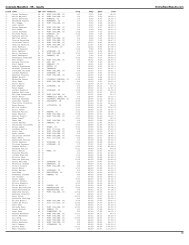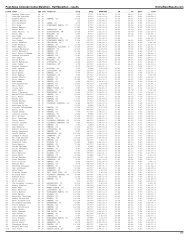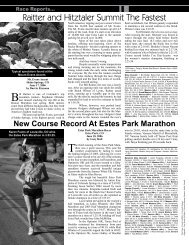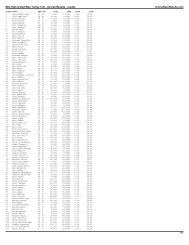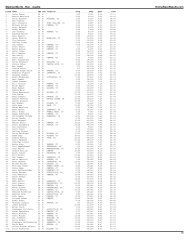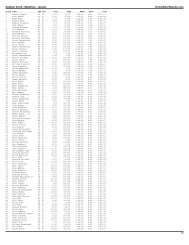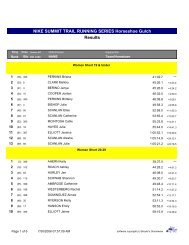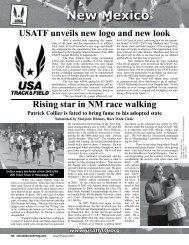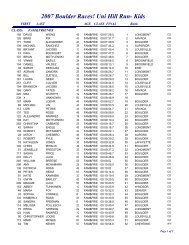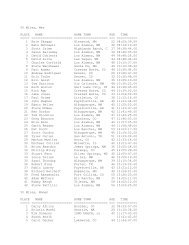Climbing the Food Pyramid - Colorado Runner
Climbing the Food Pyramid - Colorado Runner
Climbing the Food Pyramid - Colorado Runner
You also want an ePaper? Increase the reach of your titles
YUMPU automatically turns print PDFs into web optimized ePapers that Google loves.
so athletes tend to drink less; sub-optimal hydration<br />
could hinder performance.<br />
Protein For Recovery<br />
• The jury is out whe<strong>the</strong>r protein (or<br />
amino acids, <strong>the</strong> building blocks of protein)<br />
added to a sports drink enhances performance.<br />
But consuming a carb plus a protein beverage<br />
before or right after a muscle damaging workout<br />
does reduce post-exercise muscle soreness.<br />
<strong>Runner</strong>s who took branch-chain amino acids<br />
(that readily convert into glucose for fuel) before<br />
and after each of three daily bouts of hard<br />
exercise reported less muscle soreness and fatigue.<br />
The researchers attributed this to having<br />
less muscle damage and inflammation.<br />
• Does <strong>the</strong> amino acid taurine enhance<br />
energy Doubtful. When cyclists consumed<br />
2,000 mg of taurine (double <strong>the</strong> amount<br />
in a can of Red Bull) one hour before a 90 minute<br />
bike ride followed by a time trial, <strong>the</strong> taurine<br />
offered no benefits compared to <strong>the</strong> same<br />
beverage without taurine.<br />
Protein For Building Muscles<br />
Some body builders wonder if a very<br />
high protein intake will affect <strong>the</strong>ir long-term<br />
health. An 8-week study with strength athletes<br />
who consumed 3 grams protein/kg (~1.5 grams<br />
protein/lb) showed no signs of damage to liver<br />
and kidney function. This equates to 210 grams<br />
of protein for a 154 pound athlete. That’s 35<br />
eggs!<br />
Aging And Exercise<br />
Without a doubt, exercise protects<br />
and improves our mental function (to say nothing<br />
of our overall health). The question arises:<br />
How long will it be before doctors routinely<br />
prescribe exercise<br />
• In a study of seniors who were at<br />
least 65 years old who completed a 20-week<br />
exercise program, some of <strong>the</strong> subjects actually<br />
moved from <strong>the</strong> category “demented” to “normal.”<br />
Now that’s incentive to keep moving!<br />
• While we assume that exercise<br />
is good for our health, we may overlook <strong>the</strong><br />
impact of injuries. A survey of 375 former Division-I<br />
athletes (of whom 41% had played<br />
football) indicates 36% of <strong>the</strong> former athletes<br />
vs 6% of non-athlete alums had limitations in<br />
exercise due to old injuries. Exercise wisely!!<br />
Childhood Obesity<br />
The rapid increase in childhood obesity<br />
is worrisome because so many obese kids<br />
are developing diabetes and heart disease - conditions<br />
associated with old age. One solution is<br />
to add exercise back into daily life. A safe and<br />
socially accepted way to do this is to organize<br />
a Walking School Bus in your neighborhood; a<br />
parent or hired college student chaperones <strong>the</strong><br />
group of children.<br />
Exercise can also be added into <strong>the</strong><br />
school curriculum, but many schools are reluctant<br />
to do so. The assumption is less class time<br />
will contribute to lower test scores. Not <strong>the</strong><br />
case. When students ate a free school breakfast,<br />
participated in 15 minutes of teacher-led activity<br />
each morning, and had mid-day recess before<br />
lunch, <strong>the</strong>ir test scores improved plus <strong>the</strong><br />
teachers had 58% fewer discipline referrals.<br />
Weight<br />
• Two contributors to undesired fat<br />
gain are sugar-sweetened soft drinks and a sedentary<br />
lifestyle. Contributors to successful fat<br />
loss include weekly weigh-ins, at least 30 minutes<br />
per day of (ideally, supervised) exercise,<br />
and daily food records. Standing more often<br />
also helps with weight management. That is,<br />
obese people - who tend to sit 2.5 hours more<br />
per day than <strong>the</strong>ir lean counterparts - can potentially<br />
save 350 calories per day. Get rid of<br />
<strong>the</strong> chairs!<br />
• Yes, achieving a healthy weight is<br />
important. But <strong>the</strong> desire to get too thin can<br />
lead to health problems. Among 80 varsity high<br />
school athletes at an all-girls school, 74% had<br />
at least one component of <strong>the</strong> Female Athlete<br />
Triad - a syndrome with loss of menstrual periods,<br />
disordered eating, and stress fractures.<br />
Fifty-five percent ate inadequate calories, 30%<br />
had a history of amenorrhea, and 19% a history<br />
of stress fractures. Is “thin at any price” worth<br />
<strong>the</strong> cost..<br />
Body Image<br />
While you are exercycling at <strong>the</strong><br />
gym, be forewarned: If you look at magazine<br />
ads with ultra-fit bodies, you may experience<br />
increased anxiety and depression and a change<br />
of mood. Choose your magazines carefully!<br />
September/October 2006 coloradorunnermag.com 17<br />
<br />
<br />
<br />
<br />
<br />
<br />
<br />
<br />
<br />
<br />
<br />
CALL FOR FREE<br />
CONSULTATION.<br />
<br />
<br />
<br />
<br />
303-475-9863<br />
simicapm@msn.com



